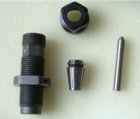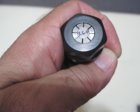Joe R
Gold $$ Contributor
I know that everyone likes to control neck tension with bushings but to me that doesn't seem like a very good way. From my way of thinking bushings transfer any variance in neck thickness to the inside of the neck where they have a direct impact on neck tension. That is not a good thing, because no matter how careful you are turning necks there will be variances, and those variances will impact neck tension.
I believe that the outside of the neck has minimal importance. The only important thing is how thick the necks are because that has an influence on spring-back. IMO the part of the neck everyone should be focusing on is the inside of the neck, or more appropriately inside diameter. The inside diameter is what influences neck tension, if one can transfer neck wall variances to the outside of the case it is that much better.
So the question is how do we control neck tension from the inside of the neck? What if instead of honing die necks (an irreversible and often problematic process because dies are hardened, not to mention that you have to be twice as accurate with a die then with a mandrel, an impossible task) we were to use a mandrel to expand the necks to provide the desired neck tension? What would a mandrel do?
Well, ... a mandrel would control the inside diameter of a case neck much more precisely than any bushing ever can. It could also transfer neck thickness variances to the outside of the neck where it doesn't interfere with neck tension and bullet release. That's good isn't it?
I have been using mandrels for thousands of cases. The problem is that just when I have a mandrel that gives ideal neck tension (down to .0001 precision) it starts to wear, and after a 1,000 cases it is done. Making another mandrel to .0001 precision is very difficult/not possible for most machine shops and grinding shops. So I set out to look for a solution.
Pin gages are small tubes 2" long and can be bought for a few dollars and they are available in dimensions as exact as .0001 (+/- .00002). They generally have a 60 to 62 Rockwell hardness, like tool steel. They are ideal for this purpose, all you have to do is bevel the tip.
Well, ... to make a long story short Kenny Porter (Porter Precision Products in Lake Jackson, Texas) made this die for me last week. The collet he used is made for lathes so it holds mandrels perfectly straight. This mandrel die makes all other mandrel die I have seen or bought look primitive.
Regards
Joe


I believe that the outside of the neck has minimal importance. The only important thing is how thick the necks are because that has an influence on spring-back. IMO the part of the neck everyone should be focusing on is the inside of the neck, or more appropriately inside diameter. The inside diameter is what influences neck tension, if one can transfer neck wall variances to the outside of the case it is that much better.
So the question is how do we control neck tension from the inside of the neck? What if instead of honing die necks (an irreversible and often problematic process because dies are hardened, not to mention that you have to be twice as accurate with a die then with a mandrel, an impossible task) we were to use a mandrel to expand the necks to provide the desired neck tension? What would a mandrel do?
Well, ... a mandrel would control the inside diameter of a case neck much more precisely than any bushing ever can. It could also transfer neck thickness variances to the outside of the neck where it doesn't interfere with neck tension and bullet release. That's good isn't it?
I have been using mandrels for thousands of cases. The problem is that just when I have a mandrel that gives ideal neck tension (down to .0001 precision) it starts to wear, and after a 1,000 cases it is done. Making another mandrel to .0001 precision is very difficult/not possible for most machine shops and grinding shops. So I set out to look for a solution.
Pin gages are small tubes 2" long and can be bought for a few dollars and they are available in dimensions as exact as .0001 (+/- .00002). They generally have a 60 to 62 Rockwell hardness, like tool steel. They are ideal for this purpose, all you have to do is bevel the tip.
Well, ... to make a long story short Kenny Porter (Porter Precision Products in Lake Jackson, Texas) made this die for me last week. The collet he used is made for lathes so it holds mandrels perfectly straight. This mandrel die makes all other mandrel die I have seen or bought look primitive.
Regards
Joe


Last edited:










